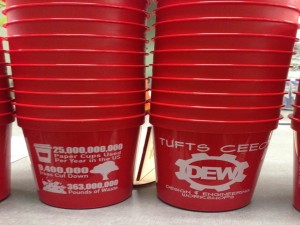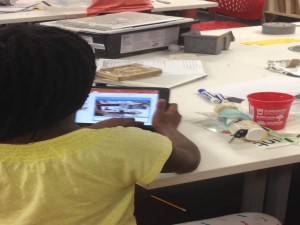Styrofoam seems to be a perpetual nightmare for environmentalists. A petroleum-based plastic foam consisting mostly of air, it can’t be composted or thrown in with most municipal recycling programs, but for many uses it remains the only practical product.
For example, when departments at Tufts order biomaterials, gel packs or dry ice, styrofoam is the only feasible shipping option, as it keeps the materials cool. Enter Emily Edwards, a staff member in the Chemical and Bioengineering Department, and Abbey Licht, a graduate student in Electrical Engineering and Computer Science, both of whom became Eco-Ambassadors in 2011 at the Science and Technology Center on our Medford campus. They grew curious when they noticed those unmistakable white shipping containers piling up outside labs and classrooms in their hallway: Could they redirect styrofoam away from landfills?
To assess how much actual need existed, Edwards and Licht began collecting the boxes from the SciTech building in a storage room. After just a month, sixty boxes had accumulated.
Hoping that a solution might already exist on campus, they first talked to Dawn Quirk, the Waste Reduction Program Manager in the Facilities Services Department, about recycling the styrofoam shipping containers. Unfortunately, while the Tufts Recycles program accepts a wide variety of glass, plastic, and metal items, styrofoam can’t go into our green bins. 
Above: a month of styrofoam.
Edwards and Licht knew of a local company that would recycle the styrofoam. ReFoamIt, based in Framingham, Massachusetts, compacts the styrofoam into logs at a plant in Rhode Island, then ships it away to be turned into toys and other consumer products. But Edwards and Licht were also aware that the boxes they were storing were at least 89% air. Could they somehow reduce the volume of the styrofoam to make for easier storage and more efficient transportation? If they handled the styrofoam themselves, would the environmental impact be lower than that of ReFoamIt’s trips to Rhode Island?
Both admit that they are first and foremost engineers, not chemists. Still, like students tackling a science class project, Edwards and Licht dove right in. They first experimented with physical change, recruiting volunteers to smash the styrofoam. They employed mallets and even had the volunteers jumping up and down on top of the boxes – but despite how light and airy styrofoam may seem, Edwards says, it’s a much harder material than one would think, and after hours of work there was little significant volume reduction. The exhausted volunteers placed the styrofoam chunks into bags to be picked up by ReFoamIt.
Not to be discouraged, Edwards and Licht next sought to turn the styrofoam back into a hard, dense plastic. Their first method was chemical: they placed pieces of the styrofoam in cups of acetone, which reduced the plastic to a goopy slime that hardened once the acetone evaporated. While the process resulted in a significant volume reduction, one bag of smashed styrofoam boxes required a whole gallon of acetone, which then evaporated into the air, so significant ventilation was required during the experiment. Moreover, the bottom of a tray of the hardening plastic took months to dry.

Above: a bag of styrofoam boxes, and the equivalent amount of hardened plastic after melting in acetone. The ratio of the volumes was about 50 to 1.
Next, Edwards and Licht melted styrofoam in a large oven at 464 degrees Fahrenheit. This experiment also successfully reduced the volume, but the process produced powerful fumes which filled the lab and the connected hallway. Moreover, only a certain amount of styrofoam could fit into the oven at a given time, so Edwards and Licht needed to open the oven periodically to add more foam, losing heat in the process.

Above: the result of melting styrofoam in an oven. The volume reduction was about the same as in the acetone experiment.
Finally, Edwards and Licht investigated alternatives to styrofoam. After hearing a story on NPR, Edwards ordered an Ecovative box made out of a mix of mushrooms and straw grown into a mold. The box’s weight is similar to that of styrofoam, but Edwards notes that the box has a slight smell and an unusual texture that might not appeal to the general public. So while the mushroom box was an interesting innovation, Edwards couldn’t see a widespread application for them at Tufts.

Above: the mushroom boxes from Ecovative.
Ultimately, Edwards and Licht determined that the most efficient, affordable and safe way to dispose of the accumulated styrofoam would be to set up a partnership with Save That Stuff, another local recycling company with which Tufts already has a relationship. Quirk organized a monthly pick-up arrangement, and it has been running smoothly ever since.

Above: sacks of styrofoam waiting for Save That Stuff.
Even though they weren’t able to find an effective way to minimize the styrofoam before sending it away, Licht and Edwards seem satisfied with the results. Licht mentions that until they started collecting the boxes in one room, she had never really thought about how much styrofoam the building used or where it all went. (Prior to their initiatives, it all went into the trash.) They seem eager to find where else this model can be applied at Tufts – there are bound to be other sites of potential improvement that go under the radar, undetected until someone dares to ask whether there might be another way.
Moving forward, Edwards and Licht and Tufts Recycles! are hoping to expand the use of the system they have established at SciTech to collect the styrofoam from labs at the Gordon Institute (200 Boston Avenue) and from the biology department.






Find Us On Social Media!